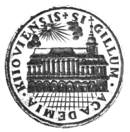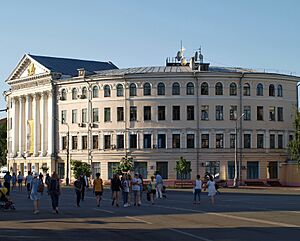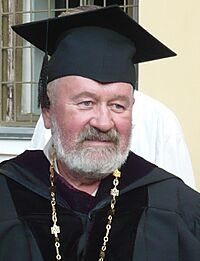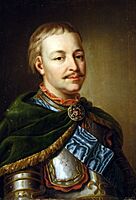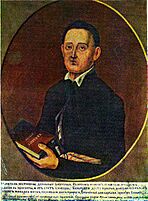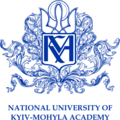National University of Kyiv-Mohyla Academy facts for kids
|
Національний університет «Києво-Могилянська академія»
ДЗВО «НаУКМА» |
|
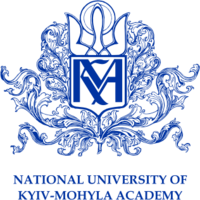 |
|
| Latin: Academia Kiioviensis Mohileana | |
|
Former names
|
|
|---|---|
| Motto | Tempus fugit, Academia sempiterna (Latin) |
|
Motto in English
|
Time passes but the Academy is eternal |
| Type | National, state-sponsored, research |
| Established |
|
| Founder | Petro Mohyla |
|
Academic affiliations
|
EUA |
| President | Serhiy Kvit |
|
Academic staff
|
180 |
| Students | c. 4000 |
| Location |
,
50°27′52″N 30°31′11″E / 50.46444°N 30.51972°E |
| Campus | Urban, 20 acres (8.1 ha) |
| Colors | Blue & White |
| Affiliations | Ministry of Education and Science of Ukraine |
|
Invalid designation
|
|
| Official name: Комплекс споруд Києво-Могилянської Академії (ансамбль Братського монастиря) (Complex of buildings of the Kyiv-Mohyla Academy (ensemble of the Brotherhood Monastery)) | |
| Type | History |
| Reference no. | 260025-Н |
The National University of Kyiv-Mohyla Academy (often called NaUKMA or Mohylianka) is a top university in Kyiv, Ukraine. It's a national university, meaning it's supported by the government. Students learn in both Ukrainian and English. NaUKMA is known for its diplomas being recognized around the world.
This university is quite small, with about 4,000 students. It takes part in many international projects with other universities, like the European University Association. NaUKMA is built on the same land where the original Kyiv-Mohyla Academy stood from 1615 to 1819. The modern university was started in 1991. Famous people like hetman Ivan Mazepa and philosopher Hryhorii Skovoroda studied at the old Academy. The university is also known for supporting Western ideas and was a key place for activists during the Orange Revolution.
Contents
History of NaUKMA
The First Kyiv-Mohyla Academy
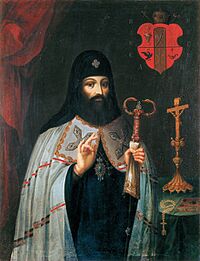
The National University of Kyiv-Mohyla Academy follows in the footsteps of the original Kyiv-Mohyla Academy. This older academy was one of the first important schools for Orthodox Christian countries in Eastern Europe. It began in 1615 as a school run by a "brotherhood" in Kyiv.
In 1632, two schools joined together to form the first higher education institution in Kyiv. This new school was called 'Mohylańska' to honor Petro Mohyla. He was a very important person who helped create the school and wanted it to use modern Western teaching methods.
In 1658, the school became an 'academy,' similar to the famous Kraków Academy. Later, in 1686, Kyiv came under Russian rule. The academy was recognized by the Russian Tsars, including Peter the Great. During the 17th and 18th centuries, it was famous for teaching leaders and thinkers from many countries, including Ukraine, Russia, and Poland. The hetmans (military leaders of the Zaporozhian Cossacks) strongly supported the academy.
Many students from the Kyiv-Mohyla Academy went to study abroad because of its excellent language programs. This helped bring new ideas from the Renaissance to Ukraine and Russia.
From Academy to Theological School
By the late 1700s, Kyiv was part of the Russian Empire. In 1817, Tsar Alexander I of Russia decided to close the academy. Even though many former students asked him to turn it into a university, he didn't. Instead, in 1819, it became the Kiev Theological Academy. This new school was only for religious studies and mainly for children of church leaders.
Over time, Kyiv needed a new, modern university. But when a new university finally opened in 1834, it was a completely new school called Saint Vladimir University, not a reopened Kyiv-Mohyla Academy.
During the Soviet Era
After the October Revolution in 1917 and the start of the Soviet Union, the government did not support religion. The Kyiv Theological Academy was closed. Its library was taken, and its main church was destroyed in 1935.
The buildings of the old academy were then used for a new Soviet military school. This school trained special political officers for the Soviet Navy. Today, one of the university buildings still has a mosaic showing Soviet symbols and quotes. When NaUKMA reopened, they decided to keep this mosaic as a reminder of the past.
Since Ukraine Became Independent
After the USSR ended in 1991, the Kyiv-Mohyla Academy was brought back to life. This happened thanks to Vyacheslav Bryukhovetsky, a Ukrainian academic who became the first president of the new 'National University of Kyiv-Mohyla Academy' (NaUKMA). This new university was the first in Ukraine to be set up like universities in North America, offering Bachelor's and Master's degrees with a credit system.
On August 24, 1992, Ukraine's first Independence Day, the first students started at NaUKMA. By June 1995, the first students graduated. Since then, NaUKMA has become known for its excellent academics and is consistently ranked as one of Ukraine's best universities.
In 1994, NaUKMA helped bring back another important Ukrainian school, the Ostroh Academy. NaUKMA also became well-known for its students and professors protesting against election fraud during the 2004 presidential election in Ukraine. After these events, a museum about the Orange Revolution was opened at NaUKMA.
Is NaUKMA the Oldest University?
NaUKMA says it's the oldest university in Kyiv and Ukraine because it's on the same land as the old Mohyla Academy. However, some people disagree because the modern university only started in 1991, after a long break of 174 years.
Other universities also claim to be the oldest. Lviv University, founded in 1661, is the oldest university in Ukraine that has been open continuously. Taras Shevchenko National University of Kyiv, started in 1834, is the oldest continuously running university in Kyiv.
What Students Learn at NaUKMA
|
Faculties of NaUKMA
|
How NaUKMA Works
NaUKMA has the highest level of approval from Ukraine's Ministry of Education and Science. It's set up like universities in North America. The school year has three terms: a long fall term, a long spring term, and a short summer term. There's also a "week of independent study" to help students catch up or prepare for exams.
Undergraduate students choose a main subject (major) and can also pick a minor subject or other elective courses. Each course gives students "credits," and grades are given on a 100-point scale. After getting a Bachelor's degree, students can continue to Master's or PhD programs. NaUKMA was the first university in Ukraine to change its PhD programs to fit the Bologna process standards, which makes degrees more similar across Europe.
NaUKMA teaches in both Ukrainian and English, though Ukrainian is the main language. It also offers special programs for international students, including a summer school for Ukrainian studies and an English-language program about Ukraine and post-Soviet countries. There's even a Master's program in German and European studies taught in German.
Students at NaUKMA receive a small monthly scholarship from the government, which depends on their grades. There are also private scholarships for top students. Students can also earn money for helping the university or promoting Ukrainian culture.
NaUKMA is a state university, managed by a board chosen by the Ukrainian government. The university's leader is the President of NaUKMA, currently Prof. Serhiy M. Kvit.
How to Get In
Anyone can apply to NaUKMA, both Ukrainian and international students. To get in, students take entrance exams. These are multiple-choice tests on subjects like Ukrainian, English, law, math, history of the Kyiv-Mohyla Academy, humanities, and natural science. The tests are scored by machines. This system was put in place to make admissions fair.
The entrance tests are known to be challenging and cover more subjects than tests at most other Ukrainian universities. Testing knowledge of the Kyiv-Mohyla Academy's history is unique, showing the university's important role in Ukrainian history. NaUKMA also has a department that helps future students prepare for these exams.
University Reputation
NaUKMA is consistently ranked as one of the best universities in Ukraine. In 2009, Delovoy magazine ranked it as the second-best university in the country. It was especially strong in humanities, economics, and law. An independent ranking of 228 Ukrainian universities also placed NaUKMA second for how well its graduates fit into the job market.
The university's business school, Kyiv Mohyla Business School, is also highly regarded. NaUKMA often welcomes visits from important foreign and national politicians.
NaUKMA in the rankings of universities in Ukraine:
| Ranking | 2007 | 2008 | 2009 | 2010 | 2011 | 2012 | 2013 |
|---|---|---|---|---|---|---|---|
| Compas | 2 | 2 | 2 | 4 | 4 | 3 | 4 |
| Zerkalo Nedeli/UNESCO | 3 | 9 | 8 | – | 5 | 4 | 4 |
| Dengi | 2 | 2 | 2 | – | – | – | – |
| Korespondent.net | 2 | 3 | – | 2 | – | 2 | 2 |
| Kommentarii: | – | – | – | 2 | – | – | – |
| Kyiv student council | – | – | 3 | – | – | – | – |
| Webometrics | – | – | 9 | 2 | 7 | 30 | – |
| 4 International Colleges & Universities | – | – | – | 9 | 16 | 7 | 92 |
Partner Institutions
After it was reestablished, NaUKMA helped other schools grow. It supported the development of the National University of Ostroh Academy, the Taras Shevchenko Pedagogical University of Kremenets, and the Petro Mohyla State University of Mykolayiv. These schools are now independent but still share an admissions system with NaUKMA. NaUKMA also works with a network of high schools in Ukraine called collegiums, which prepare students for NaUKMA's entrance exams.
The university has its own publishing house, "Kyiv-Mohyla Academy," which publishes scientific and educational books.
Universities NaUKMA Works With
NaUKMA has partnerships with many universities around the world. Here are some of them:
| Country | University | Country | University |
|---|---|---|---|
| University of Toronto | University of Helsinki | ||
| University of Manitoba | Stralsund University | ||
| University of Western Ontario | ISM University of Management and Economics | ||
| Sciences Po | BI Norwegian Business School | ||
| École Normale Supérieure | University of Warsaw |
Research at NaUKMA
Research at NaUKMA is done through its six faculties, 29 departments, and 24 research centers. Every year in January, the university holds a science conference called Dni Nauky NaUKMA (The Days of Science at NaUKMA). The main research areas are economics, law, and humanities. Many professors also work at research institutes of the National Academy of Science of Ukraine, and NaUKMA students can use their facilities for their studies.
Libraries
The original Kyiv Mohyla Academy had a large collection of books, but they were lost when the academy closed in the 1920s. Today, the university is building a modern research library. Besides the main library, there are smaller libraries for different departments and reading rooms. International cultural organizations like the Goethe-Institute, British Council, and American Library are also on campus and open to the public. NaUKMA students can also use the Vernadsky National Library of Ukraine.
Campus Life
The university is located in the historic Podil neighborhood of Kyiv, near Kontraktova Square and the Dnipro River. The campus has many buildings from its past, some dating back to the 17th century. These include the Halshka Hulevychivna house and the Mazepa building, named after Hetman Ivan Mazepa who helped fund it. The Mazepa building has a large hall for events, an art center, and the research library.
Other historic buildings include a sundial and the bursa, which was a student dormitory. The Blahovishchenska (Annunciation) Church, built in 1740 for students, is also on campus. Most other buildings were built when it was the Kyiv Theological Academy, with some additions during the Soviet era. Student dormitories are located outside the main campus.
NaUKMA also has a "Green Office" that uses energy-saving and environmentally friendly technologies. This project was started by students and is the first of its kind in a Ukrainian university.
University Traditions
When NaUKMA was reestablished, it tried to bring back old traditions from its past. It also started some new ones. Every year on October 15, the school celebrates Academy Day. On this day, students clean the monument of the famous philosopher Hryhorii Skovoroda, a former student. This is called clean Skovoroda. The Skovoroda monument is also decorated with a graduation cap during the graduation ceremony on June 28.
Another tradition at graduation is to carry the university turtle named Alma. New graduates touch her shell and make wishes. Students also perform theatrical shows called verteps, which might have started with students of the old Academy. These shows are performed during festive events.
Each academic year begins with a welcome event for new students, followed by a lecture from a famous scientist who becomes an honorary professor. New students also take a traditional student oath. During their first term, students from all departments meet each other at an "acquaintance ball."
Student Life
Even though NaUKMA has a smaller number of students (around 3,000 in 2006), there are many activities on campus. NaUKMA students are known for being active, and the university supports this. Some student groups include the Student Council, the Christian Students Union, and the ecological club Zelena Hvylya. The NaUKMA student portal Bo.Net.Ua helps students and alumni connect online.
Sports classes are required for NaUKMA students in their first two years. These include exercises, team sports like soccer and basketball, and fitness. There are also many student sports clubs, from Combat Hopak to Go. The Center of Culture and Art and the Center for Contemporary Art offer opportunities for arts and music.
Notable Alumni and Faculty
Many important people in Ukrainian history studied at the old Kyiv-Mohyla Academy. Several hetmans (leaders of the Ukrainian Cossacks) from the 17th and 18th centuries were educated here, including Ivan Mazepa and Pylyp Orlyk. The Grand Chancellor of Russia, Alexander Bezborodko, was also a graduate. The academy was a significant religious school, and many important church leaders like Stephen Yavorsky and Feofan Prokopovich studied there.
Over the years, many writers, artists, and scholars attended the Kyiv Mohyla Academy. These include writer Simeon of Polotsk, architect Ivan Hryhorovych-Barskyi, and composer Artemy Vedel. The Ukrainian philosopher Hryhorii Skovoroda was also a student. Mikhail Lomonosov, a Russian scientist who founded Moscow University, briefly studied at the Kyiv Mohyla Academy.
Even after 1819, when it became a religious school, it still had an international reputation. The Moldavian poet Alexei Mateevici and the Romanian Orthodox Church bishop Visarion Puiu were alumni.
Today, graduates of NaUKMA work in many fields, including national and international companies, research, and government. Many also continue their studies abroad. Famous alumni of the modern NaUKMA include journalist and politician Andriy Shevchenko and writers Myroslav Laiuk and Maryna Sokolyan.
Images for kids


